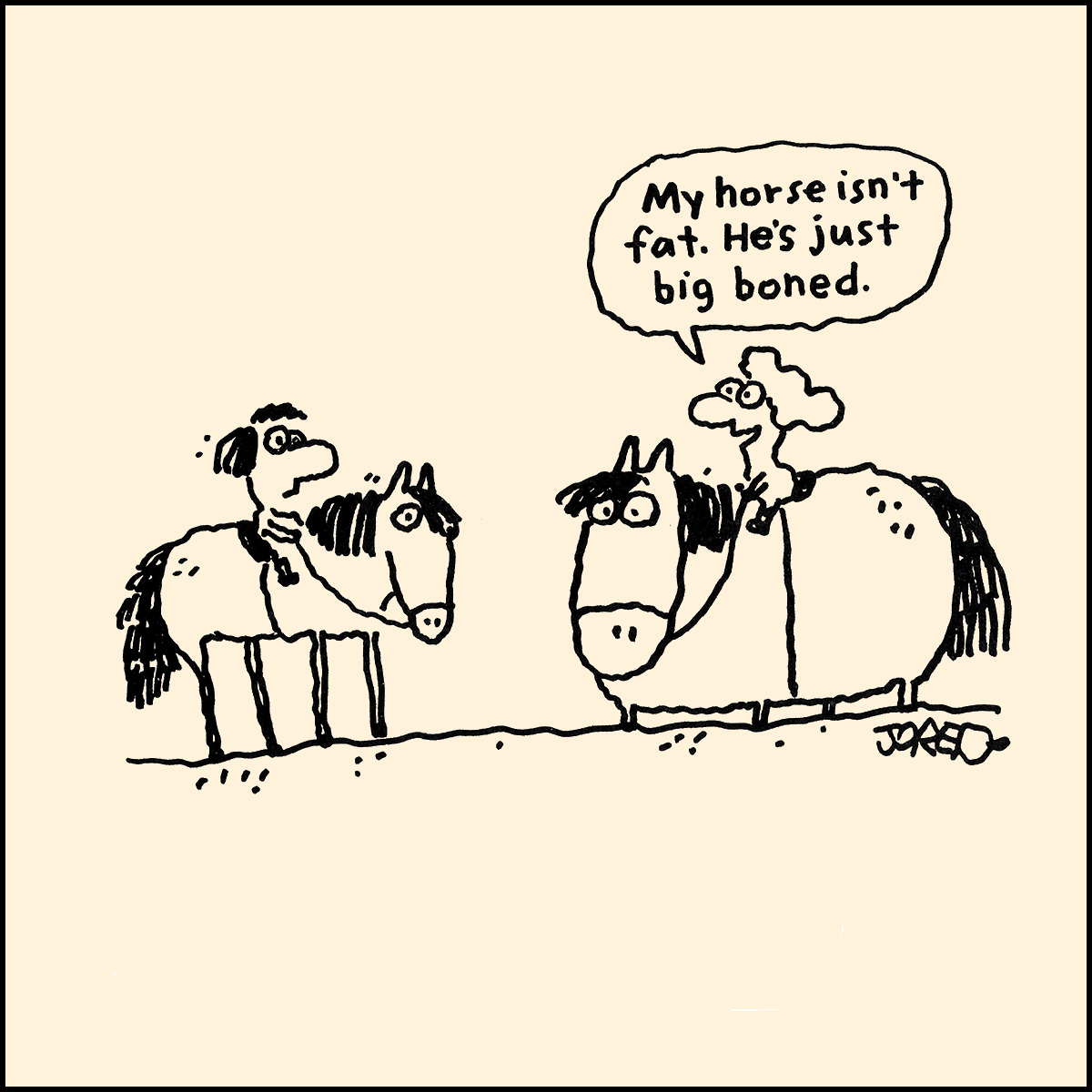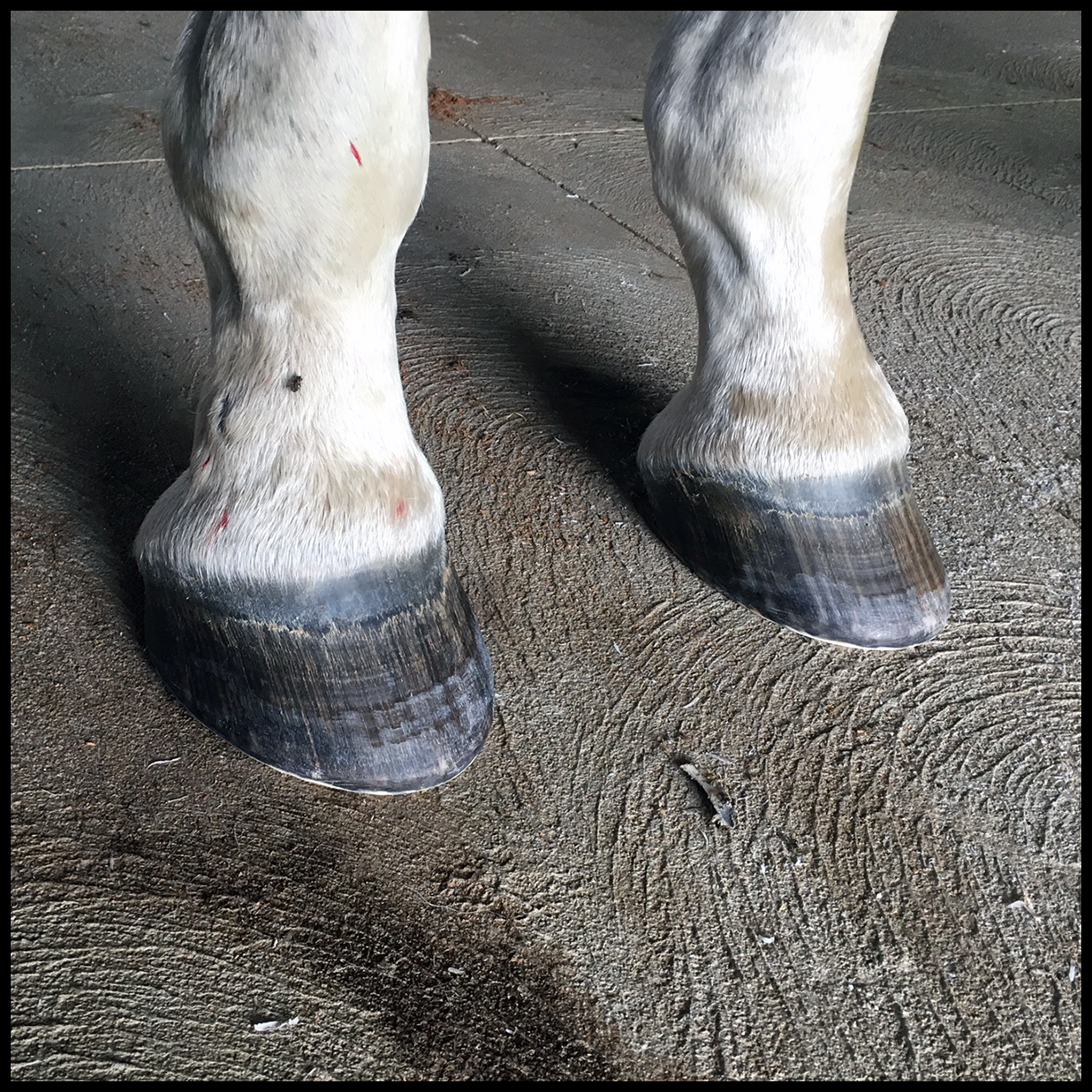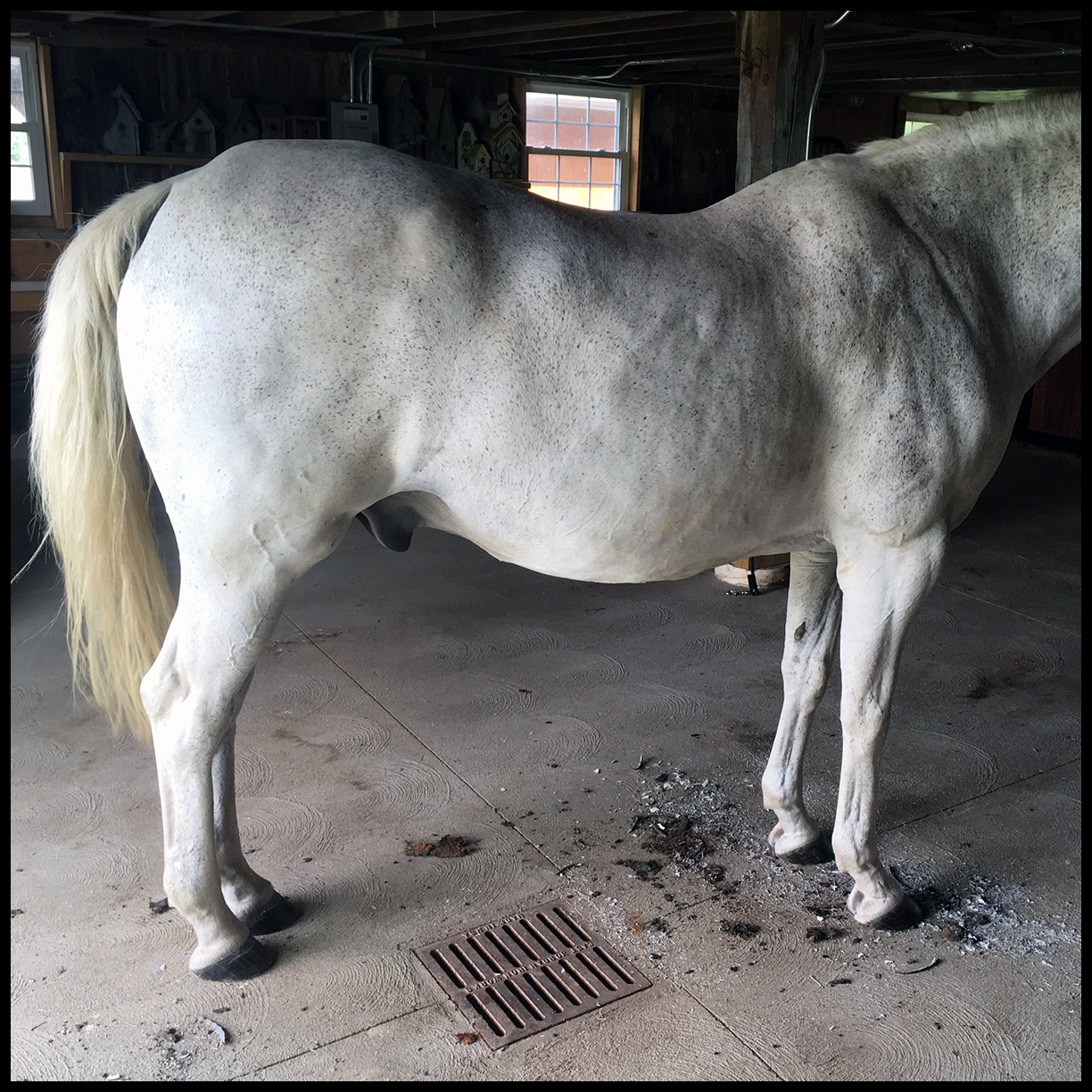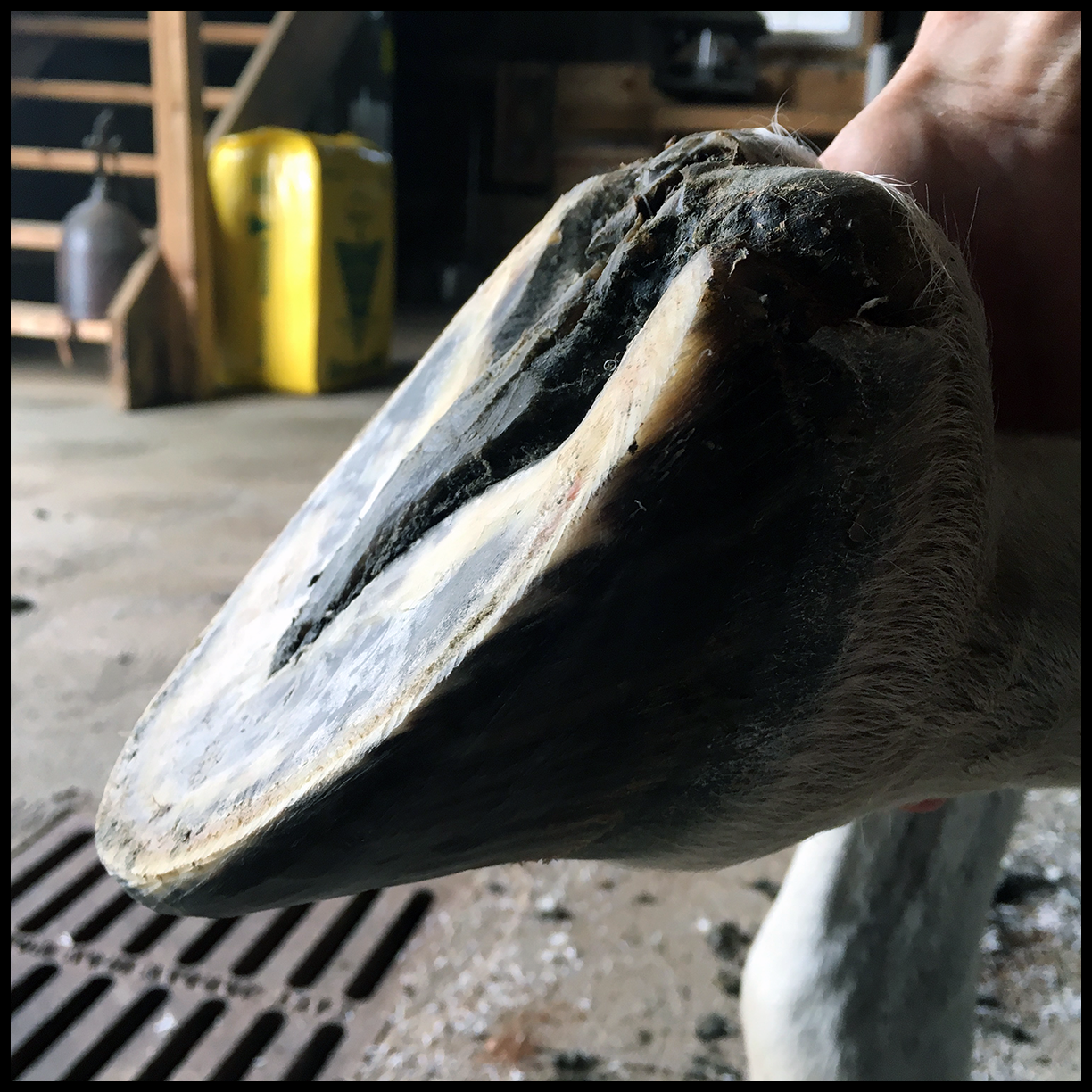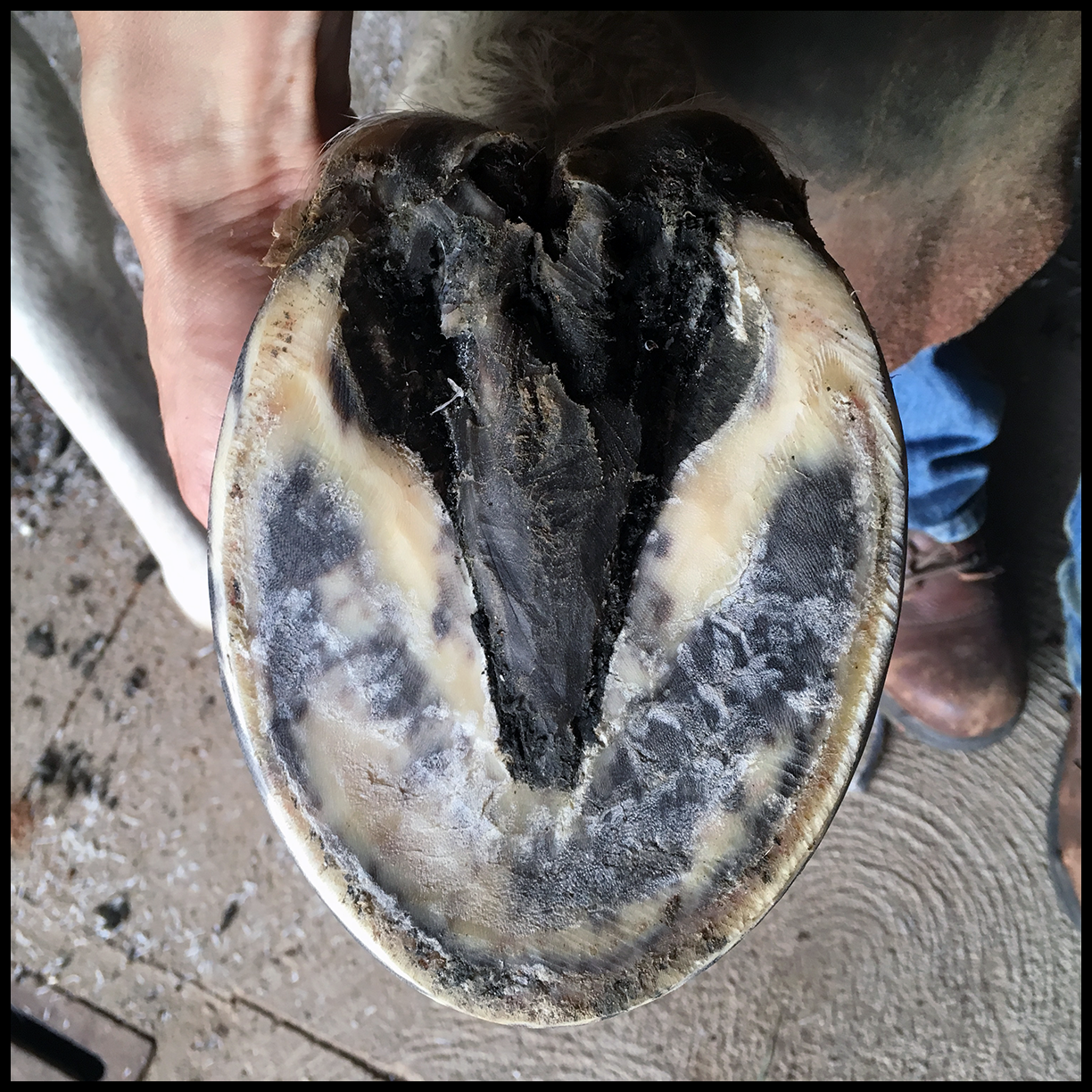“You’re killing your horse!” I exclaimed. The woman had just related how her geriatric Morgan was on constant grass pasture, with continuous access to hay, and now also being fed what she described as “just over twelve pounds of feed a day.” “But the vet told me I need to put weight on him!” she protested. Dora and I weren’t concerned about his weight at that particular moment; we were worried about what we were seeing in his feet: flat soles, very stretched white lines, sore to the point of being unwilling to lift his feet, and – most disturbing of all – soft, squishy sole tissue directly beneath the coffin bones. And if he continued on that course, we knew it would only be a short time before his coffin bones penetrated his soles…
Four years ago, I wrote an article entitled How Much is Too Much? that described research done by one of my university colleagues on the question of how much weight a horse can carry without evidence of muscle damage. And while riders too heavy for their horses continue to be a serious problem (for their horses, certainly!), overweight horses such as Jared Lee’s “big-boned” cartoon horse and the very real horse described above are all-too-typical examples of what we now see on a near-daily basis.
“So what’s the big deal about a few extra pounds on my horse?” you may ask. Well, it’s because these “big-boned” horses have taken the first (or second or third) step on the path toward a condition known as endocrinopathic laminitis – an extremely common form of laminitis now recognized as distinctly different from the laminitis caused by the sudden excessive intake of carbohydrates that occurs, for example, when a horse gets into the feed room. So when we encounter an overweight horse accompanied by word that he was “a bit sensitive” after his last trim, we can pretty well predict what his feet are going to look like before we’re even close enough to see them properly. Along with increased post-trim sensitivity, they’ll often exhibit:
- A loss of solar concavity i.e. flattening of the soles as the coffin bone descends
- Sole bruising, particularly below the coffin bone
- Separation of the white line at the toe, eventually extending all the way around the hoof
- Flaring of the hoof wall at the toe, eventually extending all the way around the hoof
- Horizontal rings and waves in the hoof wall rather than normal straight growth
- Frequent hoof abscessing
Unfortunately, and to the disservice of horses and horse owners (and hoof care providers), many veterinarians have been slow to keep up with research on this condition, instead clinging to the outdated belief that horses presenting with clinical symptoms consistent with laminitis (some of which are listed above) but without an “obvious” cause for laminitis must actually have some other condition. Yet, as a recent article in The Veterinary Journal points out –
Endocrinopathic laminitis is now recognized as the most common form of naturally occurring laminitis in horses and ponies presenting primarily with lameness in developed countries….An earlier misconception that laminitis was predominantly associated with sepsis or SIRS arose from its prevalence in equids treated at veterinary referral hospitals, where laminitis research is concentrated….This misperception was highlighted by a large epidemiological study in the USA, which showed that grain overload, retained placenta, colic or diarrhoea accounted for only 12% of owner-reported cases of laminitis; the remainder were associated with dietary problems or obesity, or were of unknown cause. Subsequent, more convincing studies from the USA and Europe identified endocrinopathies (i.e. “hormone problems”) in 90% of cases of laminitis in horses/ponies presenting for lameness. (Patterson-Kane, J.C., et al. “Paradigm Shifts in Understanding Equine Laminitis.” The Veterinary Journal, vol. 231, 2018, pp. 33–40)
Please be aware that improper trimming can also cause some of these same symptoms, and it can occasionally be challenging to sort out the real culprit! But if you haven’t changed hoof care providers and your horse is now showing signs of having sensitive feet, you should first consider whether or not any or all of the following are true.
If your horse is:
- Objectively overweight i.e. a Body Condition Score (BCS) of 6 or higher,
- Regularly consuming more calories than are required to maintain his body weight,
- No longer doing as much work as he was previously doing, but his caloric intake hasn’t been reduced,
- Being fed differently than when he was sound, including treats and supplements, and/or
- Consuming any grass,
there’s an extremely good chance the sensitivity he’s experiencing is a symptom of the early stages of endocrinopathic laminitis. Again – your vet probably won’t recognize it as such, because most veterinarians simply don’t have the experience or expertise to recognize the subtle (at least to them!) changes in the feet that signal potential disaster looming over the horizon. But the foot is a marvelous “early warning system” for dietary and other health/management issues, so if your hoof care provider is properly trained – admittedly a big “if” as well – he/she should see what the vet and others may not. So ask questions, and listen carefully to the answers. I can’t emphasize this enough: endocrinopathic laminitis, like any other form of laminitis, is an extremely painful condition, yet the condition can usually be avoided if the diet is properly managed. And while it’s definitely treatable, with full recovery possible, it’s certainly much easier to spare you and your horse by attempting to prevent it in the first place by ensuring your horse stays at a healthy weight (4.5 – 5.5 BCS).
Contrary to what most horse owners I talk to seem to think, it’s really neither difficult nor time-consuming to do the math to figure out approximately how many calories your horse requires to maintain a proper body weight for the amount of work he’s doing. But keep in mind that all calorie information and feed calculations are based on weight, not volume, which means that whoever feeds your horse should be weighing his hay and feed. And although you should only need to correlate weight with volume once for a given brand and type of feed e.g. “this orange scoop full of HappyHorse Brand SuprGood Feed has a net (feed) weight of 3 pounds,” hay varies tremendously and each feeding should be weighed!
Remember: In order to help prevent possible endocrinopathic laminitis problems, it’s extremely important that you be objective about your horse and his situation:
- Be honest about your horse’s current weight and BCS
- Be honest about how much work your horse is actually doing
- Be honest about what your horse should weigh
- Be honest about what and how much your horse is consuming
I realize many horse owners think horses are “supposed” to be round-looking, or that horses look “healthier” or “cuter” with “a few extra pounds.” But believe me: they’re not, it’s not, and they don’t! So please do the right thing and do right by your horse.
I intend to cover treatment options for the horse who does develop laminitis in a future article. But for now, let me just mention that putting shoes on a laminitic horse – even a mildly laminitic one whose only obvious symptom is foot sensitivity – is absolutely the wrong thing to do, and will actually increase pain and delay healing in spite of what others may try to convince you of! So if you find yourself in that situation, do your horse a huge favor and resist the urge to shoe him; I promise you I’ll provide a well-thought-out and logical explanation in an upcoming article.
And what of the Morgan described at the beginning of this article? Well, after a great deal of discussion with the owner, including assurances that her horse wasn’t going to starve to death any time soon, we managed to convince her to eliminate the “just over twelve pounds of feed a day” from her horse’s diet. And just as has been the case with other clients’ horses, his feet recovered fairly quickly. In fact, by the time his next trim came around a few weeks later, the sensitivity was gone and the sole tissue was a normal consistency with obvious returning concavity!
I do feel compelled to say that in this particular situation, I place a lot of the blame for the horse’s pain on the veterinarian’s lack of proper education, although I cannot say for certain whether the feeding regimen was the vet’s idea, the owner’s idea, or a combination of both. Regardless, even a few minutes of contemplation should lead any reasonable person to figure out that adding nearly 19,000 calories per day to any horse’s diet – particularly one whose caloric intake should be in the 13,000 – 14,000 total calories per day range – makes absolutely no sense at all.
As I keep saying: Question everyone and everything, no matter the source of the advice…and don’t overfeed your horse!
